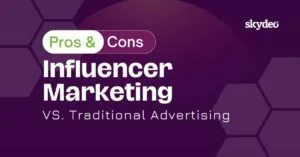
In today's digital age, influencer marketing has emerged as a powerful strategy for brands to connect with their target audiences. As consumers increasingly turn to social media and online platforms for recommendations and information, influencer marketing has gained significant traction. In fact, most consumers said that they would purchase an ebook (77%) or software (78%) if they read a positive recommendation through social media. However, it's important to understand the pros and cons of influencer marketing vs. traditional advertising methods to make informed marketing decisions.
Traditional advertising refers to conventional methods of promotion, such as TV commercials, print ads, billboards, and radio spots. While these methods have long been effective in reaching mass audiences, they face limitations in the face of evolving consumer behavior. With the rise of ad-blockers, cord-cutting, and ad-skipping, it has become challenging to capture consumers' attention solely through traditional advertising channels.
Influencer marketing involves collaborating with individuals who have a dedicated following and influence over a specific target audience. Influencers can be categorized into micro-influencers, macro-influencers, or celebrity influencers, depending on their reach and niche. One of the key advantages of influencer marketing is its ability to create authentic connections with consumers, leveraging the trust and credibility that influencers have established with their audiences.
While influencer marketing has numerous advantages, it's essential to acknowledge its limitations as well.
Rather than viewing influencer marketing vs. traditional advertising as competing strategies, businesses can leverage the strengths of both approaches by integrating them effectively. Combining influencer collaborations with traditional advertising channels can amplify brand messaging and maximize the impact on the target audience. For example, brands can create TV commercials featuring influencers, or use influencer-generated content in print advertisements to increase authenticity and engagement.
At Skydeo, we understand the power of influencer marketing in reaching and engaging with target audiences. Our deterministic data provides valuable insights into consumer behavior, interests, and demographics, enabling businesses to identify the right audiences for their influencer campaigns. By using Skydeo data, you can optimize your influencer marketing efforts by using enhanced targeting precision, and ultimately driving better results and ROI.
Influencer marketing and traditional advertising each have their pros and cons, and the most effective marketing strategies often incorporate elements of both. Influencer marketing offers authenticity, targeted reach, and cost-effectiveness, while traditional advertising provides mass exposure and brand recognition. By understanding the strengths and limitations of each approach, businesses can make informed decisions and create integrated marketing campaigns that deliver powerful results.
For more information about influencer marketing, check out “Influencer Marketing: How to Find The Right Audience”. And if you’re ready to take your campaigns to the next level with precise ad targeting, contact us today or request a free quote on any segments.
Follow us on all your favorite platforms to stay updated with the latest news and events!
LinkedIn: https://www.linkedin.com/company/skydeo/
Instagram: https://www.instagram.com/skydeoinc/
Twitter: https://twitter.com/SkydeoInc
And don’t forget to subscribe to our monthly segment release to get the latest info on which audience segments should be on your radar each month!